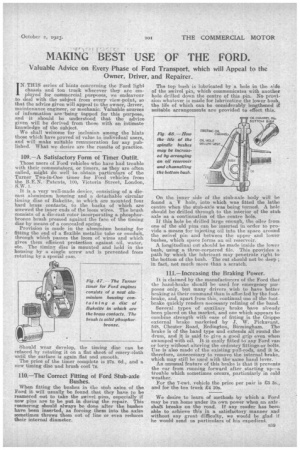MAKING BEST BEST USE OF THE FORD.
Page 25

If you've noticed an error in this article please click here to report it so we can fix it.
Valuable Advice on CA/cry Phase of Ford Transport, which will Appeal to the Owner, Driver, and Repairer.
IN. THIS series of hints concerning the Ford light chassis and ton truck wherever they are employed for commercial purposes, we endeavour to deal with the subject from every view-point, so that the advice given will appeal to the owner, driver, maintenance engineer, or mechanic. Valuable sources of information are 'being tapped for this purpose, and it should be understood that the advice given will be derived front those with an intimate knowledge of the subject.
We shall welcome for inclusion among the hints those which have proved of value to individual users, and will make suitable remuneration for any published. What we desire are the results of practice.
109.—A Satisfactory Form of Timer Outfit.
Those users of Ford vehicles who have had trouble with their commutators, or timers, as they are often called, might do well to obtain particulars of the Turner Two-in-One timer for Yard vehicles from the B.E.N. Patents, 100, Victoria Street, London, S.W. 1.
It is a very well-made device, consisting of a diecast aluminium housing and a detachable circular timing disc of Bakelite, in which are mounted four hard brass contacts, to the backs of which are screwed the inner ends of the loom wires. The brush consists of a die-cast rotor incorporating a phosphorbronze brush pressed against the face of the timing disc by means of a concealed spring.
Provision is made in the aluminium housing for fitting the end of a flexible metallic tube or conduit, through which passes the loom of wires and which gives them efficient protection against oil, water, etc. The timingdisc is mounted and held in the housing by a single screw and is prevented from rotating by a special cam.
Should wear develop, the timing disc can be refaced by rotating it on a flat sheet of emery-cloth until the surface is again flat and smooth. The price of the timer complete is 27s. Bel., and a new timing disc and brush cost 7s.
110.—The Correct Fitting of Ford Stub-axle Bushes.
When fitting the bushes in the stub axles of the Ford it will usually be found that they have to be reamered out to take the swivel pins, especially if new pins are to be put in during the repair. This reentering should always be done after the bushes have been inserted, as forcing them into the axles sometimes throws them out of line or even reduces their internal diameter.
The top bush is lubricated by a hole in the side of the swivel pin, which communicates with another hole drilled down the centre of this pin. No provision whatever is made for lubricating the lower bush, the life of which can be considerably lengthened if suitable arrangements are provided to effect this.
On the inner side of the stub-axle body will be found a V hole, into which was fitted the lathe centre when the stub-axle was being turned. A hole should be drilled through to the interior of the stub axle as a continuation of the centre hole.
If this hole be drilled large enough, the oiler from one of the old pins can be inserted in order to provide a means for injecting oil into the space around the swivel pin and between the upper and lower bushes, which space forms an oil reservoir.
A longitudinal cut should be made inside the lower bush, using a three-cornered file. This provides a path by which the lubricant may penetrate right to the bottom of the bush. The cut should not be deep ; in fact, not much more than a scratch.
W.—Increasing the Braking Power.
It is claimed by the manufacturers of the Ford that the hand-brake shoula be used for emergency purposes only, but many drivers wish to have better braking at their command than is afforded by the footbrake, and, apart from this, continual use of the foot:brake quickly renders necessary relining of the band.
Several types of auxiliary brake have already been placed on the market, and one which appears to combine strength with ease of fitting is the Grippe external brake marketed by j. W. Pickavant, 548, Chester Road, Erdington, Birmingham. The brake is of the band type and extends all round the drum, and it is said to give a good grip even when swamped with oil. It it easily fitted to any Ford van or lorry without altering the ordinary fittings or bolts. Use is also made of the existing pull-reds, and it is, therefore, unnecessary to remove the internal brake, which may still be used with the same band lever.
An unusual feature of this brake is that it prevents the car from running forward after starting up—a trouble which sometimes occurs, particularly in cold weather.
For the 7-cwt. vehicle the price per pair is 23 3s., and for the ton truck £4 10s.
We desire to learn of methods by which a Ford may be run home under its own power when an axleshaft breaks on the road. If any reader has been able to achieve this in a satisfactory manner aud without any great difficulty, we would be glad if he would send us particulars of his expedient..
































